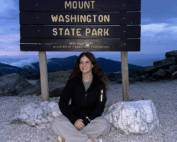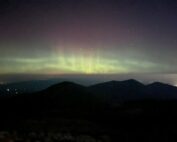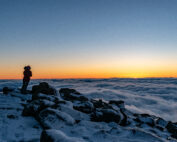Examining Strong Winter Winds
2015-03-29 19:49:53.000 – Nate Iannuccillo, Summit Intern
So why are the winds so high, and why is the location of the highs and lows so important?
We need to understand a few things in order to explain this.
First, what causes wind?
Wind is caused by differences in pressure, and wind is the movement of air in an attempt to balance out these pressure differences.
So if this makes sense, the greater the difference in pressure, the faster the air moves, and the greater the wind speeds.
The same thing happens with winds, and for this reason, winds flow roughly parallel to the black lines.
But as I’m sure you can imagine, it’s a little more complicated, and it involves a little more physics.
As you may have noticed, the pressure lines are not very straight; in fact, they’re quite wavy and curved. Understanding the effect the curvature has on these forces is important.
We’ll employ another analogy to help us understand what’s going on.
Think about performing the classic “Around the World” yo-yo trick. You’re spinning the yo-yo in a circle over your head, by your feet, and eventually back to your hand. There is always a centrifugal force that pushes the yo-yo outward, but is always at least partially held in place by tension from the string.
What is important in this analogy is to understand the role that gravity plays. When the yo-yo is above your head, gravity is opposite the direction of the centrifugal force, so there is less tension needed to balance out the forces. But when the yo-yo is by your feet, gravity is in the same direction as the centrifugal force, so the force of tension provided by the string needs to be much higher.
As these forces increase while entering the lower half of the yo-yo’s trajectory, it cause the yo-yo to move faster by your feet than when it is overhead and the forces are dampened.
This same type of thing happens in the atmosphere, except different forces are involved.
When air circulates around high pressure systems, the centrifugal force pushes outward in the same direction as the pressure gradient force pointing from high to low pressure. When these forces stack up, wind speeds ramp up.
We see this happening to some extent in each of these cases. Deep low pressure systems create significant pressure gradients accompanied by a high pressure ridge pushing in from the west. This combines to create exceptionally strong winds on the backside of the low.
Next time you see high winds in the forecast, take a look at a forecast map and check out what’s going on!
Nate Iannuccillo, Summit Intern
From Weather Observer to Intern, to Observer Again
From Weather Observer to Intern, to Observer Again By Madelynn Smith As I rode in the backseat of our Obs van up the Auto Road for the first time as a full-time employee at
From Mountains to More Mountains
From Mountains to More Mountains: This Time with Stronger Winds By Alyssa Bélanger On the observation deck in high winds. Hello there! My name is Alyssa Bélanger and I am a fall
From Summit to Sign-Off: My Farewell to the Rockpile
From Summit to Sign-Off: My Farewell to the Rockpile By Amy Cotter Enjoying my last Mount Washington sunset (for now) on September 13, 2025. After two incredible years with the Mount Washington




